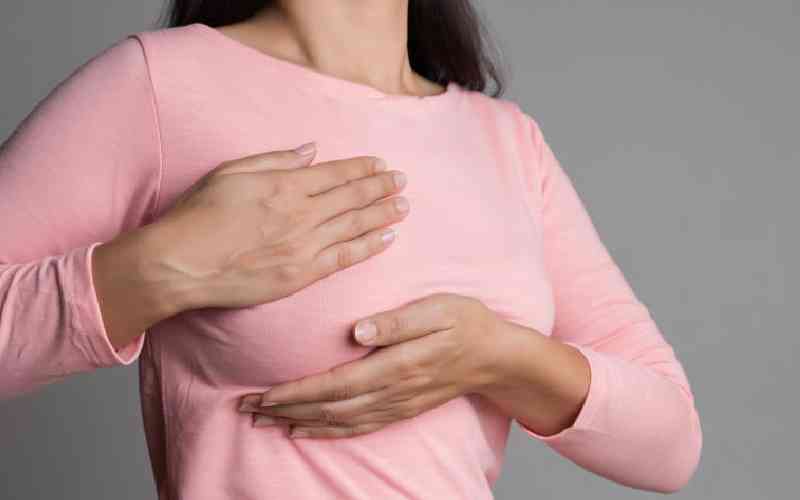
A majority of women will get one or more fibroids at some point in their lifetime. In fact, fibroids are considered the most common type of tumour that occurs in women of reproductive age.
During an interview, Dr Alfred Mukomba highlights that fibroids are more common in the African race. According to doctors at the Aga Khan University Hospital in Nairobi, one in every five women, especially in their reproductive years, has fibroids. By the age of 50, 80 per cent of women are likely to have developed fibroids.
Fibroids are largely ignored
Fibroids — medically known as myomas or leiomyomas — are usually benign smooth muscle cell tumours that can occur at any part of the uterus.
Their growth is possibly motivated by delayed motherhood and extended intake of hormonal contraceptives. “To those who get pregnant early, fibroids tend not to grow as much.
But during pregnancy, because of the high hormone levels, the fibroids can grow to a very large size from a very small size within that very short time,” says Dr Mukomba.
It is typical of fibroids to stop growing by the time a woman reaches menopause. Fibroids are not life-threatening, but they have the potential to profoundly impact a woman’s quality of life. They may not interfere with ovulation, but they may affect a woman’s ability to carry a pregnancy to term.
Fibroids can be;
Submucosal - growing directly under the uterine lining
Intramural - embedded within the wall of the uterus
Subserosal - bulging outward from the uterine ling
Pendunculated - hanging from a stem within or outside the uterus. They cause serious pain when they twist about their stems.
Complications
Pain
Since fibroids are largely asymptomatic, most women cannot even tell whether they have them or not. However, some women may experience a high degree of pain and discomfort during menses or sexual intercourse.
Pendunculated fibroids pain is so intense that it interferes with one’s ability to perform normally especially during monthly periods. Some women complain of increased bleeding, lower back pain, discomfort when bending and painful defecation.
Big belly
Fibroids vary in size. They may grow as lone tumours or cluster in groups inside or outside the uterus. Women with several large fibroids are often mistaken to be about 20 weeks with child.
Fibroids can make the belly feel big and bloated, akin to what one feels when they have had too much to eat. It could be frustrating when you seem to do all you can to lose an enlarged tummy with no success. Your fibroids could be to blame.
Frequent urination
Since the uterus is located right above the bladder, the weight of fibroids can increase the pressure on the bladder, forcing you to head to the bathroom every now and then.
Fibroids can also cause urine retention as they prevent full emptying of the bladder. Urine retention has been sighted as a major source of breeding bacteria that eventually cause urinary tract infectionn (UTI).
Risky pregnancy
The presence of fibroids may not always cause problems during pregnancy. However, they can cause mechanical distortion of the uterus wall and alter embryo implantation.
In pregnancy, large fibroids can potentially move the growing foetus to a position that makes natural delivery difficult or even dangerous.
Depending on their size and location, fibroids have also been documented to stress the uterus causing preterm birth, premature rupture of membranes or miscarriage.
A study published in PubMed links fibroids located in the lower uterine segment to placenta retention after vaginal delivery. Retained placenta is considered as one of the major causes of postpartum haemorrhage, which is a major cause of maternal deaths.
Abnormal bleeding
Doctors at the Kenya Laparoscopic Surgery Services warn that fibroids interfere with blood flow in the uterine wall lining. This can cause prolonged and painful periods. Women who bleed excessively end up developing anaemia.
Treatment for fibroids is available. The type of treatment depends on the location, size and manifesting symptoms associated with them. Options for treatment according to the Aga Khan University Hospital include:
· Uterine Fibroid Embolisation – a painless, non-surgical procedure that involves the insertion of a thin catheter through a 2mm ‘cut’. The catheter releases a substance that blocks the blood supply to the fibroids. The fibroids soften and shrink in size due to the deprivation of blood and nutrients. Patients are safe to conceive after the operation, but are advised to wait for six months before trying.
· Open myomectomy – open surgery to remove fibroids. It is done when the patient aims to preserve her ability to bear children.
· Abdominal hysterectomy - recommended for women who have large fibroids and have completed their families. It involves the removal of the uterus through a lower abdomen incision. Vaginal hysterectomy can also be recommended for medium-sized fibroids.
· Laparoscopic myomectomy - a less invasive procedure compared to open myomectomy. The surgeon may remove the fibroids robotically through incisions of 0.5cm to 1.5cm on the abdomen. A laparoscopic hysterectomy removes the entire uterus through such incisions.
Open surgeries are associated with long and painful recovery with an elevated risk of infection and bleeding.
 The Standard Group Plc is a multi-media organization with investments in media
platforms spanning newspaper print
operations, television, radio broadcasting, digital and online services. The
Standard Group is recognized as a
leading multi-media house in Kenya with a key influence in matters of national
and international interest.
The Standard Group Plc is a multi-media organization with investments in media
platforms spanning newspaper print
operations, television, radio broadcasting, digital and online services. The
Standard Group is recognized as a
leading multi-media house in Kenya with a key influence in matters of national
and international interest.










